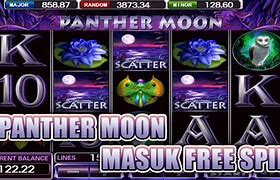
Panther Moon Modal 10 Juta Berapa
Pre-telescopic observation (before 1609)
It is believed by some that the oldest cave paintings from up to 40,000 BP of bulls and geometric shapes,[220] or 20–30,000 year old tally sticks were used to observe the phases of the Moon, keeping time using the waxing and waning of the Moon's phases.[221] One of the earliest-discovered possible depictions of the Moon is a 3,000 BCE rock carving Orthostat 47 at Knowth, Ireland.[222][223] Lunar deities like Nanna/Sin featuring crescents are found since the 3rd millennium BCE.[224] Though the oldest found and identified astronomical depiction of the Moon is the Nebra sky disc from c. 1800–1600 BCE.[225][226]
The ancient Greek philosopher Anaxagoras (d. 428 BC) reasoned that the Sun and Moon were both giant spherical rocks, and that the latter reflected the light of the former.[230][231]: 227 Elsewhere in the 5th century BC to 4th century BC, Babylonian astronomers had recorded the 18-year Saros cycle of lunar eclipses,[232] and Indian astronomers had described the Moon's monthly elongation.[233] The Chinese astronomer Shi Shen (fl. 4th century BC) gave instructions for predicting solar and lunar eclipses.[231]: 411
In Aristotle's (384–322 BC) description of the universe, the Moon marked the boundary between the spheres of the mutable elements (earth, water, air and fire), and the imperishable stars of aether, an influential philosophy that would dominate for centuries.[234] Archimedes (287–212 BC) designed a planetarium that could calculate the motions of the Moon and other objects in the Solar System.[235] In the 2nd century BC, Seleucus of Seleucia correctly thought that tides were due to the attraction of the Moon, and that their height depends on the Moon's position relative to the Sun.[236] In the same century, Aristarchus computed the size and distance of the Moon from Earth, obtaining a value of about twenty times the radius of Earth for the distance.
The Chinese of the Han dynasty believed the Moon to be energy equated to qi and their 'radiating influence' theory recognized that the light of the Moon was merely a reflection of the Sun; Jing Fang (78–37 BC) noted the sphericity of the Moon.[231]: 413–414 Ptolemy (90–168 AD) greatly improved on the numbers of Aristarchus, calculating a mean distance of 59 times Earth's radius and a diameter of 0.292 Earth diameters, close to the correct values of about 60 and 0.273 respectively.[237] In the 2nd century AD, Lucian wrote the novel A True Story, in which the heroes travel to the Moon and meet its inhabitants. In 510 AD, the Indian astronomer Aryabhata mentioned in his Aryabhatiya that reflected sunlight is the cause of the shining of the Moon.[238][239] The astronomer and physicist Ibn al-Haytham (965–1039) found that sunlight was not reflected from the Moon like a mirror, but that light was emitted from every part of the Moon's sunlit surface in all directions.[240] Shen Kuo (1031–1095) of the Song dynasty created an allegory equating the waxing and waning of the Moon to a round ball of reflective silver that, when doused with white powder and viewed from the side, would appear to be a crescent.[231]: 415–416 During the Middle Ages, before the invention of the telescope, the Moon was increasingly recognized as a sphere, though many believed that it was "perfectly smooth".[241]
Gunakan aplikasi penghasil uang
Saat ini, sudah banyak aplikasi penghasil uang yang tersedia di Google Play Store maupun Apple Store. Ada banyak jenis aplikasi penghasil uang yang aman dan benar-benar menghasilkan cuan untukmu.
Aplikasi-aplikasi tersebut biasanya mengharuskan kamu mengerjakan sebuah misi atau tugas tertentu di dalam aplikasinya. Jika berhasil menyelesaikannya, kamu akan mendapat koin atau poin yang nantinya bisa ditukar dengan uang tunai.
Lanjutkan membaca artikel di bawah
Meski hasilnya cenderung kecil, jika kamu melakukannya secara rutin dan mencoba fitur-fitur lainnya. Bukan tidak mungkin kamu bisa memperoleh cuan yang lebih besar.
Baca Juga: 10 Cara Mendapatkan Uang dari Telegram, Tambah Cuan!
Illumination and phases
Half of the Moon's surface is always illuminated by the Sun (except during a lunar eclipse). Earth also reflects light onto the Moon, observable at times as Earthlight when it is reflected back to Earth from areas of the near side of the Moon that are not illuminated by the Sun.
Since the Moon's axial tilt with respect to the ecliptic is 1.5427°, in every draconic year (346.62 days) the Sun moves from being 1.5427° north of the lunar equator to being 1.5427° south of it and then back, just as on Earth the Sun moves from the Tropic of Cancer to the Tropic of Capricorn and back once every tropical year. The poles of the Moon are therefore in the dark for half a draconic year (or with only part of the Sun visible) and then lit for half a draconic year. The amount of sunlight falling on horizontal areas near the poles depends on the altitude angle of the Sun. But these "seasons" have little effect in more equatorial areas.
With the different positions of the Moon, different areas of it are illuminated by the Sun. This illumination of different lunar areas, as viewed from Earth, produces the different lunar phases during the synodic month. The phase is equal to the area of the visible lunar sphere that is illuminated by the Sun. This area or degree of illumination is given by ( 1 − cos e ) / 2 = sin 2 ( e / 2 ) {\displaystyle (1-\cos e)/2=\sin ^{2}(e/2)} , where e {\displaystyle e} is the elongation (i.e., the angle between Moon, the observer on Earth, and the Sun).
Brightness and apparent size of the Moon changes also due to its elliptic orbit around Earth. At perigee (closest), since the Moon is up to 14% closer to Earth than at apogee (most distant), it subtends a solid angle which is up to 30% larger. Consequently, given the same phase, the Moon's brightness also varies by up to 30% between apogee and perigee.[207] A full (or new) moon at such a position is called a supermoon.[201][202][208]
There has been historical controversy over whether observed features on the Moon's surface change over time. Today, many of these claims are thought to be illusory, resulting from observation under different lighting conditions, poor astronomical seeing, or inadequate drawings. However, outgassing does occasionally occur and could be responsible for a minor percentage of the reported lunar transient phenomena. Recently, it has been suggested that a roughly 3 km (1.9 mi) diameter region of the lunar surface was modified by a gas release event about a million years ago.[209][210]
The Moon has an exceptionally low albedo, giving it a reflectance that is slightly brighter than that of worn asphalt. Despite this, it is the brightest object in the sky after the Sun.[72][j] This is due partly to the brightness enhancement of the opposition surge; the Moon at quarter phase is only one-tenth as bright, rather than half as bright, as at full moon.[211] Additionally, color constancy in the visual system recalibrates the relations between the colors of an object and its surroundings, and because the surrounding sky is comparatively dark, the sunlit Moon is perceived as a bright object. The edges of the full moon seem as bright as the center, without limb darkening, because of the reflective properties of lunar soil, which retroreflects light more towards the Sun than in other directions. The Moon's color depends on the light the Moon reflects, which in turn depends on the Moon's surface and its features, having for example large darker regions. In general the lunar surface reflects a brown-tinged gray light.[212]
At times, the Moon can appear red or blue. It may appear red during a lunar eclipse, because of the red spectrum of the Sun's light being refracted onto the Moon by Earth's atmosphere. Because of this red color, lunar eclipses are also sometimes called blood moons. The Moon can also seem red when it appears at low angles and through a thick atmosphere.
The Moon may appear blue depending on the presence of certain particles in the air,[212] such as volcanic particles,[213] in which case it can be called a blue moon.
Because the words "red moon" and "blue moon" can also be used to refer to specific full moons of the year, they do not always refer to the presence of red or blue moonlight.
Eclipses only occur when the Sun, Earth, and Moon are all in a straight line (termed "syzygy"). Solar eclipses occur at new moon, when the Moon is between the Sun and Earth. In contrast, lunar eclipses occur at full moon, when Earth is between the Sun and Moon. The apparent size of the Moon is roughly the same as that of the Sun, with both being viewed at close to one-half a degree wide. The Sun is much larger than the Moon but it is the vastly greater distance that gives it the same apparent size as the much closer and much smaller Moon from the perspective of Earth. The variations in apparent size, due to the non-circular orbits, are nearly the same as well, though occurring in different cycles. This makes possible both total (with the Moon appearing larger than the Sun) and annular (with the Moon appearing smaller than the Sun) solar eclipses.[214] In a total eclipse, the Moon completely covers the disc of the Sun and the solar corona becomes visible to the naked eye.
Because the distance between the Moon and Earth is very slowly increasing over time,[185] the angular diameter of the Moon is decreasing. As it evolves toward becoming a red giant, the size of the Sun, and its apparent diameter in the sky, are slowly increasing.[k] The combination of these two changes means that hundreds of millions of years ago, the Moon would always completely cover the Sun on solar eclipses, and no annular eclipses were possible. Likewise, hundreds of millions of years in the future, the Moon will no longer cover the Sun completely, and total solar eclipses will not occur.[215]
As the Moon's orbit around Earth is inclined by about 5.145° (5° 9') to the orbit of Earth around the Sun, eclipses do not occur at every full and new moon. For an eclipse to occur, the Moon must be near the intersection of the two orbital planes.[216] The periodicity and recurrence of eclipses of the Sun by the Moon, and of the Moon by Earth, is described by the saros, which has a period of approximately 18 years.[217]
Because the Moon continuously blocks the view of a half-degree-wide circular area of the sky,[l][218] the related phenomenon of occultation occurs when a bright star or planet passes behind the Moon and is occulted: hidden from view. In this way, a solar eclipse is an occultation of the Sun. Because the Moon is comparatively close to Earth, occultations of individual stars are not visible everywhere on the planet, nor at the same time. Because of the precession of the lunar orbit, each year different stars are occulted.[219]
Menjadi kreator konten
Jika kamu gemar membuat konten tentang apa pun, mungkin kamu bisa mencoba menjadi kreator konten di media sosial, seperti Instagram, TikTok, atau YouTube. Kamu bisa menggunakan hobimu untuk dijadikan cuan.
Misalnya hobimu adalah fotografi. Kamu bisa membuat konten video tentang tips fotografi, rekomendasi produk kamera, dan sebagainya. Contoh lainnya jika hobimu travelling, kamu bisa membuat konten video perjalanan, vlog, hingga tips-tips menarik saat jalan-jalan.
History of exploration and human presence
Modern culture representation
The perception of the Moon in modern times has been informed by telescope enabled modern astronomy and later by spaceflight enabled actual human activity at the Moon, particularly the culturally impactful lunar landings. These new insights inspired cultural references, connecting romantic reflections about the Moon[343] and speculative fiction such as science-fiction dealing with the Moon.[342][344]
Contemporarily the Moon has been seen as a place for economic expansion into space, with missions prospecting for lunar resources. This has been accompanied with renewed public and critical reflection on humanity's cultural and legal relation to the celestial body, especially regarding colonialism,[285] as in the 1970 poem "Whitey on the Moon". In this light the Moon's nature has been invoked,[316] particularly for lunar conservation[287] and as a common.[345][310][318]
In 2021 20 July, the date of the first crewed Moon landing, became the annual International Moon Day.[346]
The lunar effect is a purported unproven correlation between specific stages of the roughly 29.5-day lunar cycle and behavior and physiological changes in living beings on Earth, including humans. The Moon has long been associated with insanity and irrationality; the words lunacy and lunatic are derived from the Latin name for the Moon, Luna. Philosophers Aristotle and Pliny the Elder argued that the full moon induced insanity in susceptible individuals, believing that the brain, which is mostly water, must be affected by the Moon and its power over the tides, but the Moon's gravity is too slight to affect any single person.[347] Even today, people who believe in a lunar effect claim that admissions to psychiatric hospitals, traffic accidents, homicides or suicides increase during a full moon, but dozens of studies invalidate these claims.[347][348][349][350][351]
Position and appearance
The Moon's highest altitude at culmination varies by its lunar phase, or more correctly its orbital position, and time of the year, or more correctly the position of the Earth's axis. The full moon is highest in the sky during winter and lowest during summer (for each hemisphere respectively), with its altitude changing towards dark moon to the opposite.
At the North and South Poles the Moon is 24 hours above the horizon for two weeks every tropical month (about 27.3 days), comparable to the polar day of the tropical year. Zooplankton in the Arctic use moonlight when the Sun is below the horizon for months on end.[198]
The apparent orientation of the Moon depends on its position in the sky and the hemisphere of the Earth from which it is being viewed. In the northern hemisphere it appears upside down compared to the view from the southern hemisphere.[199] Sometimes the "horns" of a crescent moon appear to be pointing more upwards than sideways. This phenomenon is called a wet moon and occurs more frequently in the tropics.[200]
The distance between the Moon and Earth varies from around 356,400 km (221,500 mi) (perigee) to 406,700 km (252,700 mi) (apogee), making the Moon's distance and apparent size fluctuate up to 14%.[201][202] On average the Moon's angular diameter is about 0.52°, roughly the same apparent size as the Sun (see § Eclipses). In addition, a purely psychological effect, known as the Moon illusion, makes the Moon appear larger when close to the horizon.[203]
The tidally locked synchronous rotation of the Moon as it orbits the Earth results in it always keeping nearly the same face turned towards the planet. The side of the Moon that faces Earth is called the near side, and the opposite the far side. The far side is often inaccurately called the "dark side", but it is in fact illuminated as often as the near side: once every 29.5 Earth days. During dark moon to new moon, the near side is dark.[204]
The Moon originally rotated at a faster rate, but early in its history its rotation slowed and became tidally locked in this orientation as a result of frictional effects associated with tidal deformations caused by Earth.[205] With time, the energy of rotation of the Moon on its axis was dissipated as heat, until there was no rotation of the Moon relative to Earth. In 2016, planetary scientists using data collected on the 1998-99 NASA Lunar Prospector mission, found two hydrogen-rich areas (most likely former water ice) on opposite sides of the Moon. It is speculated that these patches were the poles of the Moon billions of years ago before it was tidally locked to Earth.[206]
Cartographic resources
Menjadi dropshipper
Usaha dropshipper juga bisa menjadi pilihan cara mendapatkan uang 1 juta dalam sehari tanpa modal. Dropship adalah sistem penjualan yang tidak mengharuskan kamu memproduksi dan menyiapkan stok barang. Kamu tinggal memasarkan produk ke berbagai platform dan mengurus pembayaran jika ada pelanggan yang membeli produk yang dijual.
Stok barangnya akan langsung dikirim dari penjual tempat kamu menjadi dropshipper menuju alamat pelanggan. Kamu bisa mempromosikannya di berbagai media sosial maupun marketplace. Biasanya penjual yang memegang stok barang akan mengirimkan materi promosi, termasuk foto produk kepada kamu.
Mengisi survei online
Salah satu cara mendapatkan uang 1 juta dalam sehari tanpa modal secara online adalah dengan mengisi survei-survei di situs web atau aplikasi di smartphone. Saat ini sudah banyak situs web dan aplikasi yang menyediakan survei online untuk kamu isi.
Jika kamu berhasil menyelesaikannya, biasanya kamu akan diberi imbalan berupa poin, koin, atau bahkan langsung berupa saldo uang. Poin atau koin yang kamu kumpulkan tadi bisa ditukar dengan uang, voucher, atau diskon pada merchant tertentu. Lumayan menguntungkan, bukan?



